Assignment about Literature Review on Advanced Nutrition
VerifiedAdded on 2022/08/24
|11
|2799
|15
Assignment
AI Summary
Contribute Materials
Your contribution can guide someone’s learning journey. Share your
documents today.
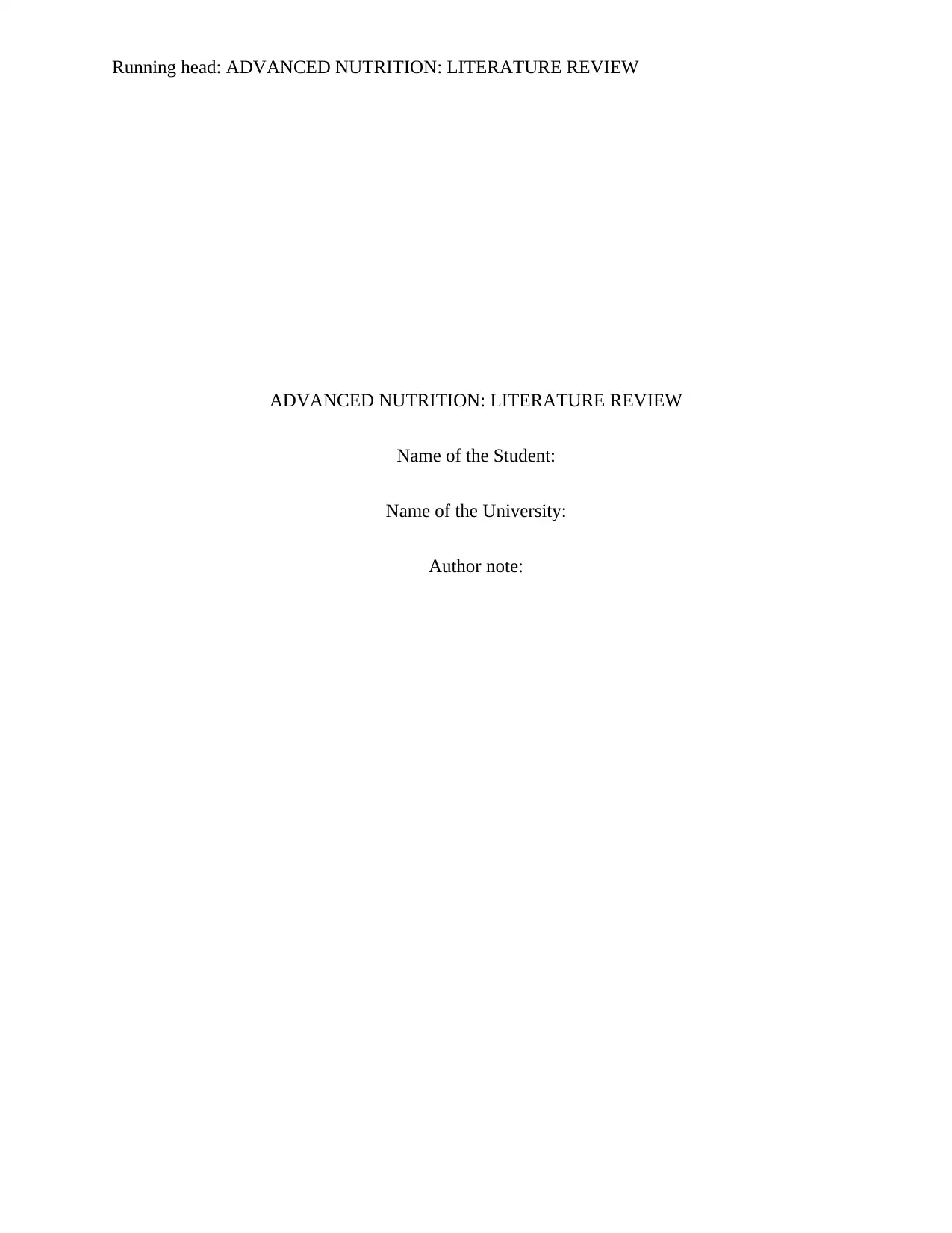
Running head: ADVANCED NUTRITION: LITERATURE REVIEW
ADVANCED NUTRITION: LITERATURE REVIEW
Name of the Student:
Name of the University:
Author note:
ADVANCED NUTRITION: LITERATURE REVIEW
Name of the Student:
Name of the University:
Author note:
Secure Best Marks with AI Grader
Need help grading? Try our AI Grader for instant feedback on your assignments.
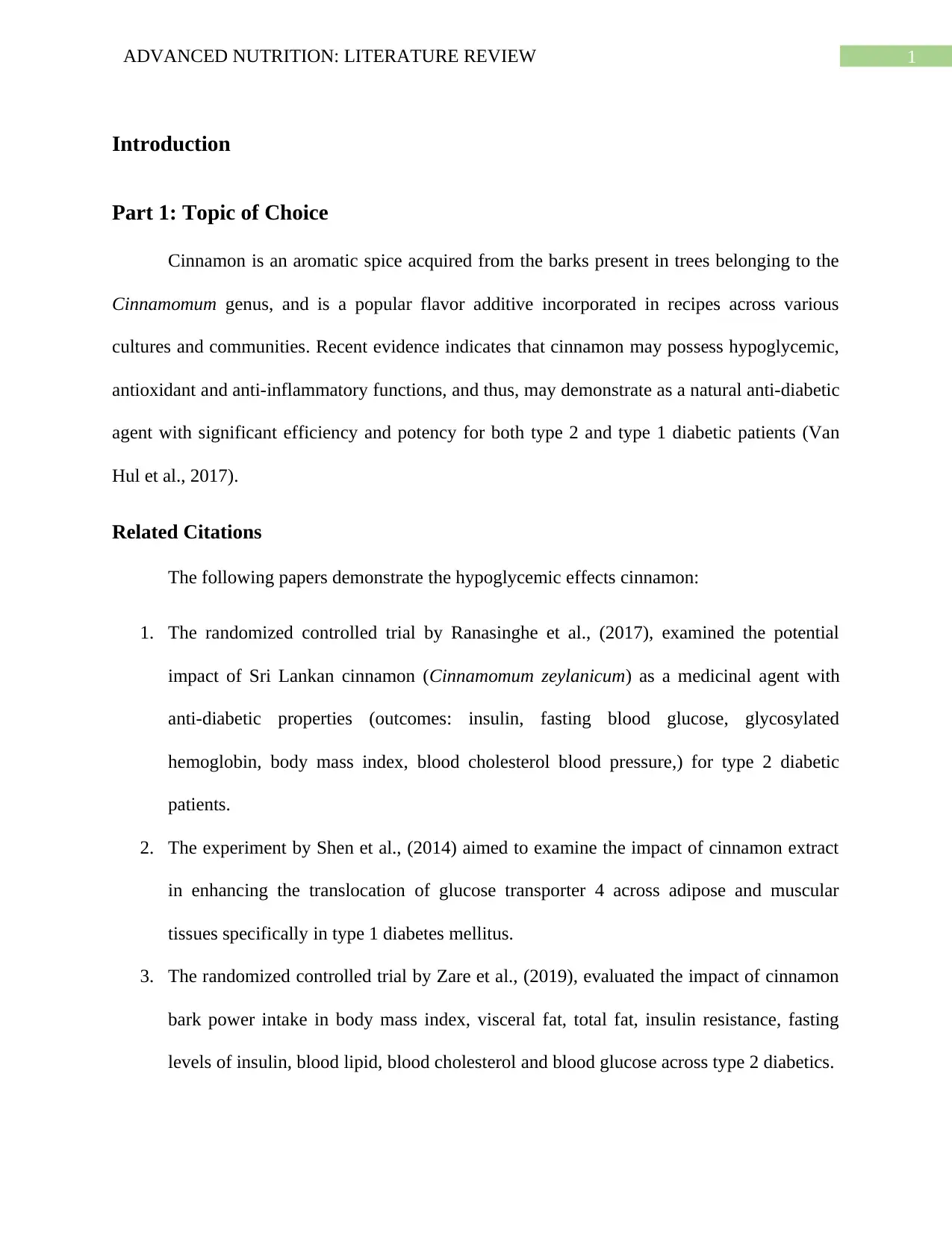
1ADVANCED NUTRITION: LITERATURE REVIEW
Introduction
Part 1: Topic of Choice
Cinnamon is an aromatic spice acquired from the barks present in trees belonging to the
Cinnamomum genus, and is a popular flavor additive incorporated in recipes across various
cultures and communities. Recent evidence indicates that cinnamon may possess hypoglycemic,
antioxidant and anti-inflammatory functions, and thus, may demonstrate as a natural anti-diabetic
agent with significant efficiency and potency for both type 2 and type 1 diabetic patients (Van
Hul et al., 2017).
Related Citations
The following papers demonstrate the hypoglycemic effects cinnamon:
1. The randomized controlled trial by Ranasinghe et al., (2017), examined the potential
impact of Sri Lankan cinnamon (Cinnamomum zeylanicum) as a medicinal agent with
anti-diabetic properties (outcomes: insulin, fasting blood glucose, glycosylated
hemoglobin, body mass index, blood cholesterol blood pressure,) for type 2 diabetic
patients.
2. The experiment by Shen et al., (2014) aimed to examine the impact of cinnamon extract
in enhancing the translocation of glucose transporter 4 across adipose and muscular
tissues specifically in type 1 diabetes mellitus.
3. The randomized controlled trial by Zare et al., (2019), evaluated the impact of cinnamon
bark power intake in body mass index, visceral fat, total fat, insulin resistance, fasting
levels of insulin, blood lipid, blood cholesterol and blood glucose across type 2 diabetics.
Introduction
Part 1: Topic of Choice
Cinnamon is an aromatic spice acquired from the barks present in trees belonging to the
Cinnamomum genus, and is a popular flavor additive incorporated in recipes across various
cultures and communities. Recent evidence indicates that cinnamon may possess hypoglycemic,
antioxidant and anti-inflammatory functions, and thus, may demonstrate as a natural anti-diabetic
agent with significant efficiency and potency for both type 2 and type 1 diabetic patients (Van
Hul et al., 2017).
Related Citations
The following papers demonstrate the hypoglycemic effects cinnamon:
1. The randomized controlled trial by Ranasinghe et al., (2017), examined the potential
impact of Sri Lankan cinnamon (Cinnamomum zeylanicum) as a medicinal agent with
anti-diabetic properties (outcomes: insulin, fasting blood glucose, glycosylated
hemoglobin, body mass index, blood cholesterol blood pressure,) for type 2 diabetic
patients.
2. The experiment by Shen et al., (2014) aimed to examine the impact of cinnamon extract
in enhancing the translocation of glucose transporter 4 across adipose and muscular
tissues specifically in type 1 diabetes mellitus.
3. The randomized controlled trial by Zare et al., (2019), evaluated the impact of cinnamon
bark power intake in body mass index, visceral fat, total fat, insulin resistance, fasting
levels of insulin, blood lipid, blood cholesterol and blood glucose across type 2 diabetics.
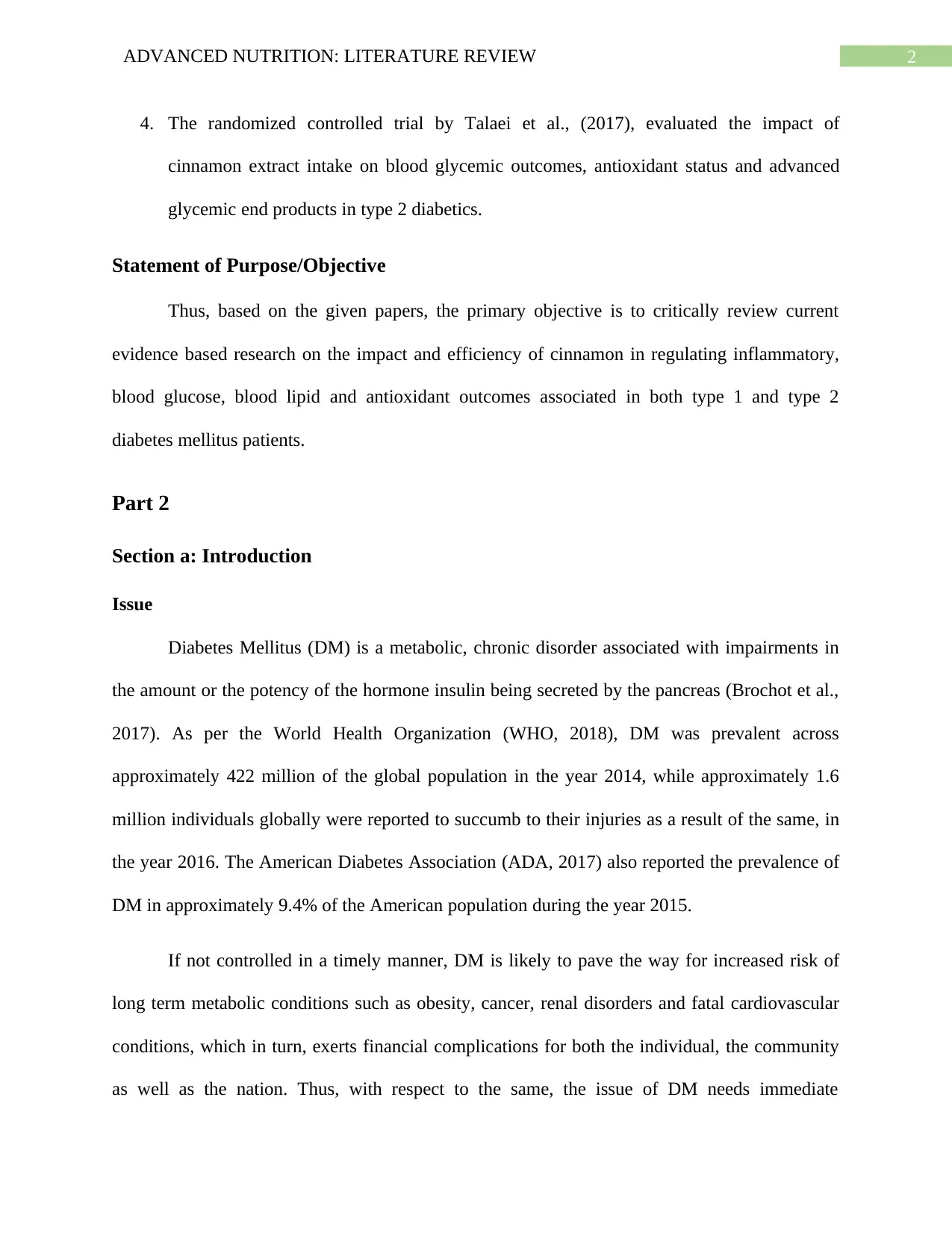
2ADVANCED NUTRITION: LITERATURE REVIEW
4. The randomized controlled trial by Talaei et al., (2017), evaluated the impact of
cinnamon extract intake on blood glycemic outcomes, antioxidant status and advanced
glycemic end products in type 2 diabetics.
Statement of Purpose/Objective
Thus, based on the given papers, the primary objective is to critically review current
evidence based research on the impact and efficiency of cinnamon in regulating inflammatory,
blood glucose, blood lipid and antioxidant outcomes associated in both type 1 and type 2
diabetes mellitus patients.
Part 2
Section a: Introduction
Issue
Diabetes Mellitus (DM) is a metabolic, chronic disorder associated with impairments in
the amount or the potency of the hormone insulin being secreted by the pancreas (Brochot et al.,
2017). As per the World Health Organization (WHO, 2018), DM was prevalent across
approximately 422 million of the global population in the year 2014, while approximately 1.6
million individuals globally were reported to succumb to their injuries as a result of the same, in
the year 2016. The American Diabetes Association (ADA, 2017) also reported the prevalence of
DM in approximately 9.4% of the American population during the year 2015.
If not controlled in a timely manner, DM is likely to pave the way for increased risk of
long term metabolic conditions such as obesity, cancer, renal disorders and fatal cardiovascular
conditions, which in turn, exerts financial complications for both the individual, the community
as well as the nation. Thus, with respect to the same, the issue of DM needs immediate
4. The randomized controlled trial by Talaei et al., (2017), evaluated the impact of
cinnamon extract intake on blood glycemic outcomes, antioxidant status and advanced
glycemic end products in type 2 diabetics.
Statement of Purpose/Objective
Thus, based on the given papers, the primary objective is to critically review current
evidence based research on the impact and efficiency of cinnamon in regulating inflammatory,
blood glucose, blood lipid and antioxidant outcomes associated in both type 1 and type 2
diabetes mellitus patients.
Part 2
Section a: Introduction
Issue
Diabetes Mellitus (DM) is a metabolic, chronic disorder associated with impairments in
the amount or the potency of the hormone insulin being secreted by the pancreas (Brochot et al.,
2017). As per the World Health Organization (WHO, 2018), DM was prevalent across
approximately 422 million of the global population in the year 2014, while approximately 1.6
million individuals globally were reported to succumb to their injuries as a result of the same, in
the year 2016. The American Diabetes Association (ADA, 2017) also reported the prevalence of
DM in approximately 9.4% of the American population during the year 2015.
If not controlled in a timely manner, DM is likely to pave the way for increased risk of
long term metabolic conditions such as obesity, cancer, renal disorders and fatal cardiovascular
conditions, which in turn, exerts financial complications for both the individual, the community
as well as the nation. Thus, with respect to the same, the issue of DM needs immediate
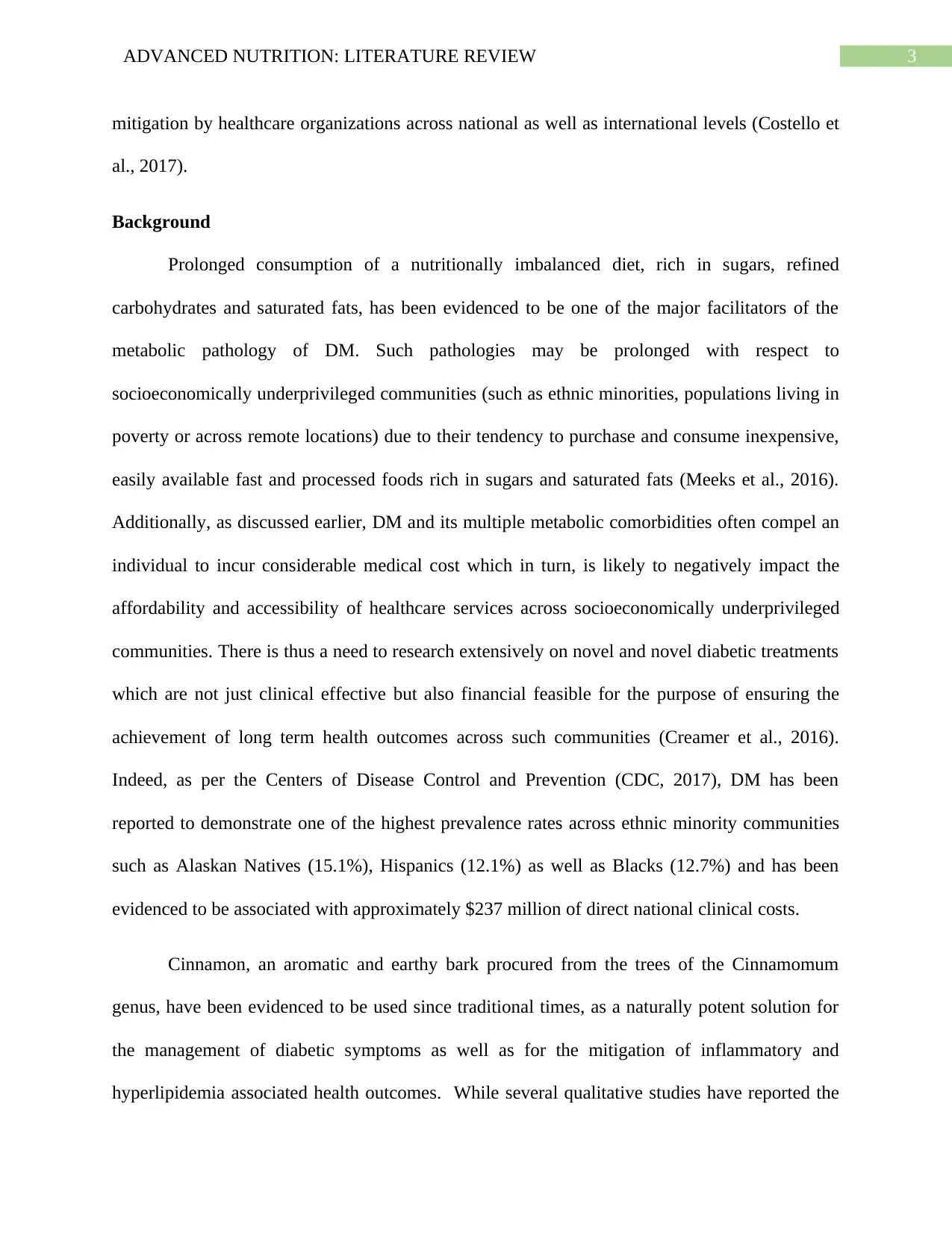
3ADVANCED NUTRITION: LITERATURE REVIEW
mitigation by healthcare organizations across national as well as international levels (Costello et
al., 2017).
Background
Prolonged consumption of a nutritionally imbalanced diet, rich in sugars, refined
carbohydrates and saturated fats, has been evidenced to be one of the major facilitators of the
metabolic pathology of DM. Such pathologies may be prolonged with respect to
socioeconomically underprivileged communities (such as ethnic minorities, populations living in
poverty or across remote locations) due to their tendency to purchase and consume inexpensive,
easily available fast and processed foods rich in sugars and saturated fats (Meeks et al., 2016).
Additionally, as discussed earlier, DM and its multiple metabolic comorbidities often compel an
individual to incur considerable medical cost which in turn, is likely to negatively impact the
affordability and accessibility of healthcare services across socioeconomically underprivileged
communities. There is thus a need to research extensively on novel and novel diabetic treatments
which are not just clinical effective but also financial feasible for the purpose of ensuring the
achievement of long term health outcomes across such communities (Creamer et al., 2016).
Indeed, as per the Centers of Disease Control and Prevention (CDC, 2017), DM has been
reported to demonstrate one of the highest prevalence rates across ethnic minority communities
such as Alaskan Natives (15.1%), Hispanics (12.1%) as well as Blacks (12.7%) and has been
evidenced to be associated with approximately $237 million of direct national clinical costs.
Cinnamon, an aromatic and earthy bark procured from the trees of the Cinnamomum
genus, have been evidenced to be used since traditional times, as a naturally potent solution for
the management of diabetic symptoms as well as for the mitigation of inflammatory and
hyperlipidemia associated health outcomes. While several qualitative studies have reported the
mitigation by healthcare organizations across national as well as international levels (Costello et
al., 2017).
Background
Prolonged consumption of a nutritionally imbalanced diet, rich in sugars, refined
carbohydrates and saturated fats, has been evidenced to be one of the major facilitators of the
metabolic pathology of DM. Such pathologies may be prolonged with respect to
socioeconomically underprivileged communities (such as ethnic minorities, populations living in
poverty or across remote locations) due to their tendency to purchase and consume inexpensive,
easily available fast and processed foods rich in sugars and saturated fats (Meeks et al., 2016).
Additionally, as discussed earlier, DM and its multiple metabolic comorbidities often compel an
individual to incur considerable medical cost which in turn, is likely to negatively impact the
affordability and accessibility of healthcare services across socioeconomically underprivileged
communities. There is thus a need to research extensively on novel and novel diabetic treatments
which are not just clinical effective but also financial feasible for the purpose of ensuring the
achievement of long term health outcomes across such communities (Creamer et al., 2016).
Indeed, as per the Centers of Disease Control and Prevention (CDC, 2017), DM has been
reported to demonstrate one of the highest prevalence rates across ethnic minority communities
such as Alaskan Natives (15.1%), Hispanics (12.1%) as well as Blacks (12.7%) and has been
evidenced to be associated with approximately $237 million of direct national clinical costs.
Cinnamon, an aromatic and earthy bark procured from the trees of the Cinnamomum
genus, have been evidenced to be used since traditional times, as a naturally potent solution for
the management of diabetic symptoms as well as for the mitigation of inflammatory and
hyperlipidemia associated health outcomes. While several qualitative studies have reported the
Secure Best Marks with AI Grader
Need help grading? Try our AI Grader for instant feedback on your assignments.
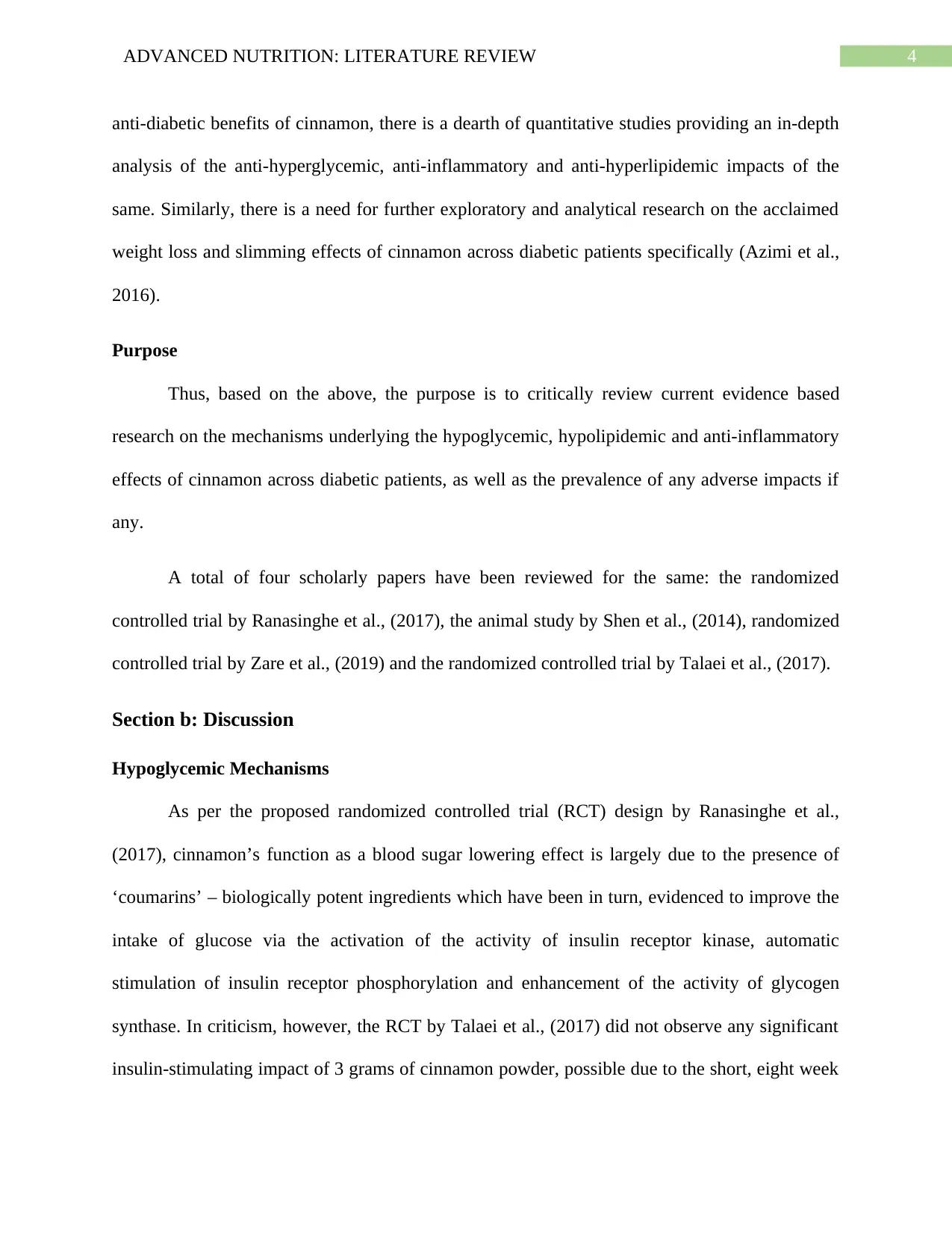
4ADVANCED NUTRITION: LITERATURE REVIEW
anti-diabetic benefits of cinnamon, there is a dearth of quantitative studies providing an in-depth
analysis of the anti-hyperglycemic, anti-inflammatory and anti-hyperlipidemic impacts of the
same. Similarly, there is a need for further exploratory and analytical research on the acclaimed
weight loss and slimming effects of cinnamon across diabetic patients specifically (Azimi et al.,
2016).
Purpose
Thus, based on the above, the purpose is to critically review current evidence based
research on the mechanisms underlying the hypoglycemic, hypolipidemic and anti-inflammatory
effects of cinnamon across diabetic patients, as well as the prevalence of any adverse impacts if
any.
A total of four scholarly papers have been reviewed for the same: the randomized
controlled trial by Ranasinghe et al., (2017), the animal study by Shen et al., (2014), randomized
controlled trial by Zare et al., (2019) and the randomized controlled trial by Talaei et al., (2017).
Section b: Discussion
Hypoglycemic Mechanisms
As per the proposed randomized controlled trial (RCT) design by Ranasinghe et al.,
(2017), cinnamon’s function as a blood sugar lowering effect is largely due to the presence of
‘coumarins’ – biologically potent ingredients which have been in turn, evidenced to improve the
intake of glucose via the activation of the activity of insulin receptor kinase, automatic
stimulation of insulin receptor phosphorylation and enhancement of the activity of glycogen
synthase. In criticism, however, the RCT by Talaei et al., (2017) did not observe any significant
insulin-stimulating impact of 3 grams of cinnamon powder, possible due to the short, eight week
anti-diabetic benefits of cinnamon, there is a dearth of quantitative studies providing an in-depth
analysis of the anti-hyperglycemic, anti-inflammatory and anti-hyperlipidemic impacts of the
same. Similarly, there is a need for further exploratory and analytical research on the acclaimed
weight loss and slimming effects of cinnamon across diabetic patients specifically (Azimi et al.,
2016).
Purpose
Thus, based on the above, the purpose is to critically review current evidence based
research on the mechanisms underlying the hypoglycemic, hypolipidemic and anti-inflammatory
effects of cinnamon across diabetic patients, as well as the prevalence of any adverse impacts if
any.
A total of four scholarly papers have been reviewed for the same: the randomized
controlled trial by Ranasinghe et al., (2017), the animal study by Shen et al., (2014), randomized
controlled trial by Zare et al., (2019) and the randomized controlled trial by Talaei et al., (2017).
Section b: Discussion
Hypoglycemic Mechanisms
As per the proposed randomized controlled trial (RCT) design by Ranasinghe et al.,
(2017), cinnamon’s function as a blood sugar lowering effect is largely due to the presence of
‘coumarins’ – biologically potent ingredients which have been in turn, evidenced to improve the
intake of glucose via the activation of the activity of insulin receptor kinase, automatic
stimulation of insulin receptor phosphorylation and enhancement of the activity of glycogen
synthase. In criticism, however, the RCT by Talaei et al., (2017) did not observe any significant
insulin-stimulating impact of 3 grams of cinnamon powder, possible due to the short, eight week
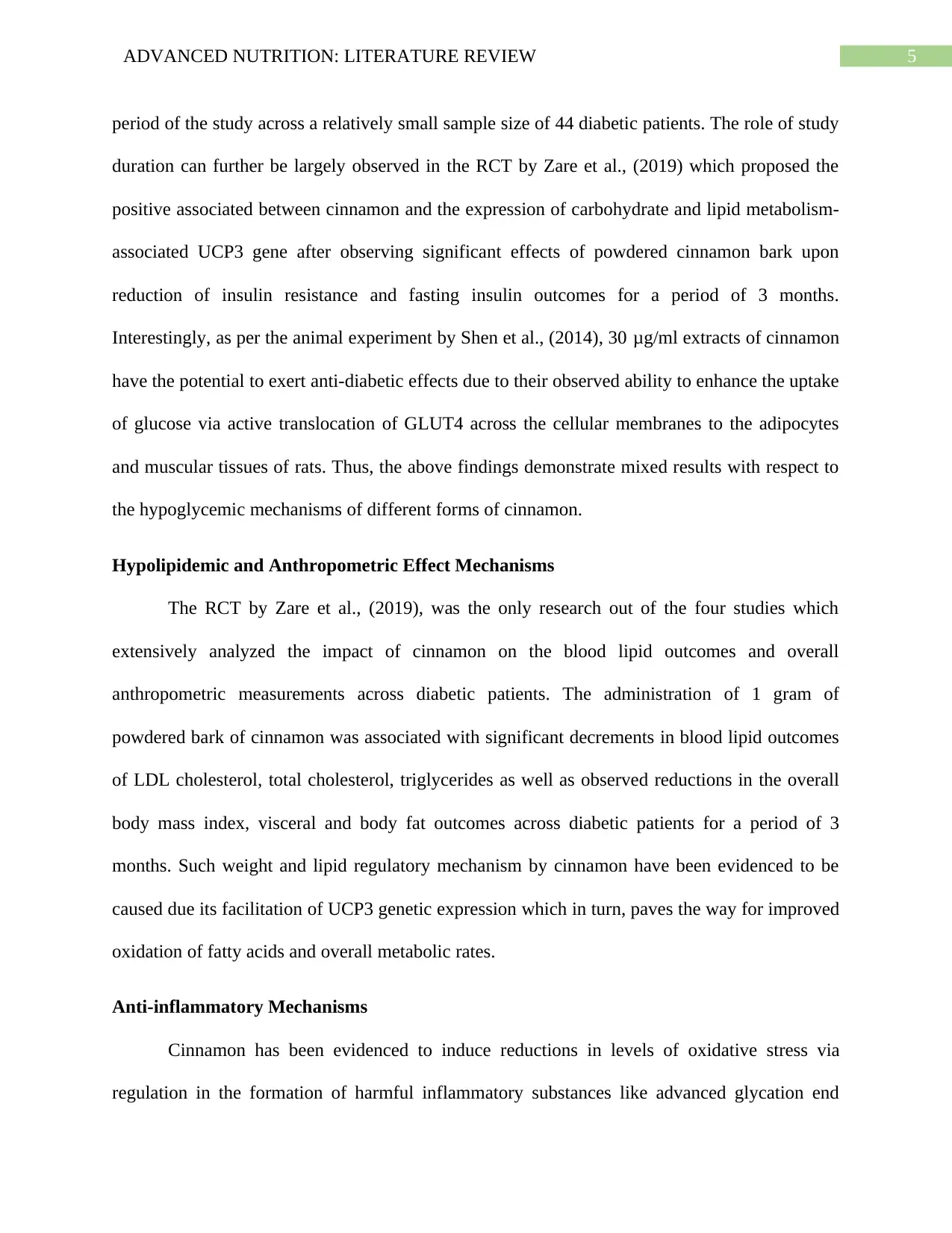
5ADVANCED NUTRITION: LITERATURE REVIEW
period of the study across a relatively small sample size of 44 diabetic patients. The role of study
duration can further be largely observed in the RCT by Zare et al., (2019) which proposed the
positive associated between cinnamon and the expression of carbohydrate and lipid metabolism-
associated UCP3 gene after observing significant effects of powdered cinnamon bark upon
reduction of insulin resistance and fasting insulin outcomes for a period of 3 months.
Interestingly, as per the animal experiment by Shen et al., (2014), 30 μg/ml extracts of cinnamon
have the potential to exert anti-diabetic effects due to their observed ability to enhance the uptake
of glucose via active translocation of GLUT4 across the cellular membranes to the adipocytes
and muscular tissues of rats. Thus, the above findings demonstrate mixed results with respect to
the hypoglycemic mechanisms of different forms of cinnamon.
Hypolipidemic and Anthropometric Effect Mechanisms
The RCT by Zare et al., (2019), was the only research out of the four studies which
extensively analyzed the impact of cinnamon on the blood lipid outcomes and overall
anthropometric measurements across diabetic patients. The administration of 1 gram of
powdered bark of cinnamon was associated with significant decrements in blood lipid outcomes
of LDL cholesterol, total cholesterol, triglycerides as well as observed reductions in the overall
body mass index, visceral and body fat outcomes across diabetic patients for a period of 3
months. Such weight and lipid regulatory mechanism by cinnamon have been evidenced to be
caused due its facilitation of UCP3 genetic expression which in turn, paves the way for improved
oxidation of fatty acids and overall metabolic rates.
Anti-inflammatory Mechanisms
Cinnamon has been evidenced to induce reductions in levels of oxidative stress via
regulation in the formation of harmful inflammatory substances like advanced glycation end
period of the study across a relatively small sample size of 44 diabetic patients. The role of study
duration can further be largely observed in the RCT by Zare et al., (2019) which proposed the
positive associated between cinnamon and the expression of carbohydrate and lipid metabolism-
associated UCP3 gene after observing significant effects of powdered cinnamon bark upon
reduction of insulin resistance and fasting insulin outcomes for a period of 3 months.
Interestingly, as per the animal experiment by Shen et al., (2014), 30 μg/ml extracts of cinnamon
have the potential to exert anti-diabetic effects due to their observed ability to enhance the uptake
of glucose via active translocation of GLUT4 across the cellular membranes to the adipocytes
and muscular tissues of rats. Thus, the above findings demonstrate mixed results with respect to
the hypoglycemic mechanisms of different forms of cinnamon.
Hypolipidemic and Anthropometric Effect Mechanisms
The RCT by Zare et al., (2019), was the only research out of the four studies which
extensively analyzed the impact of cinnamon on the blood lipid outcomes and overall
anthropometric measurements across diabetic patients. The administration of 1 gram of
powdered bark of cinnamon was associated with significant decrements in blood lipid outcomes
of LDL cholesterol, total cholesterol, triglycerides as well as observed reductions in the overall
body mass index, visceral and body fat outcomes across diabetic patients for a period of 3
months. Such weight and lipid regulatory mechanism by cinnamon have been evidenced to be
caused due its facilitation of UCP3 genetic expression which in turn, paves the way for improved
oxidation of fatty acids and overall metabolic rates.
Anti-inflammatory Mechanisms
Cinnamon has been evidenced to induce reductions in levels of oxidative stress via
regulation in the formation of harmful inflammatory substances like advanced glycation end
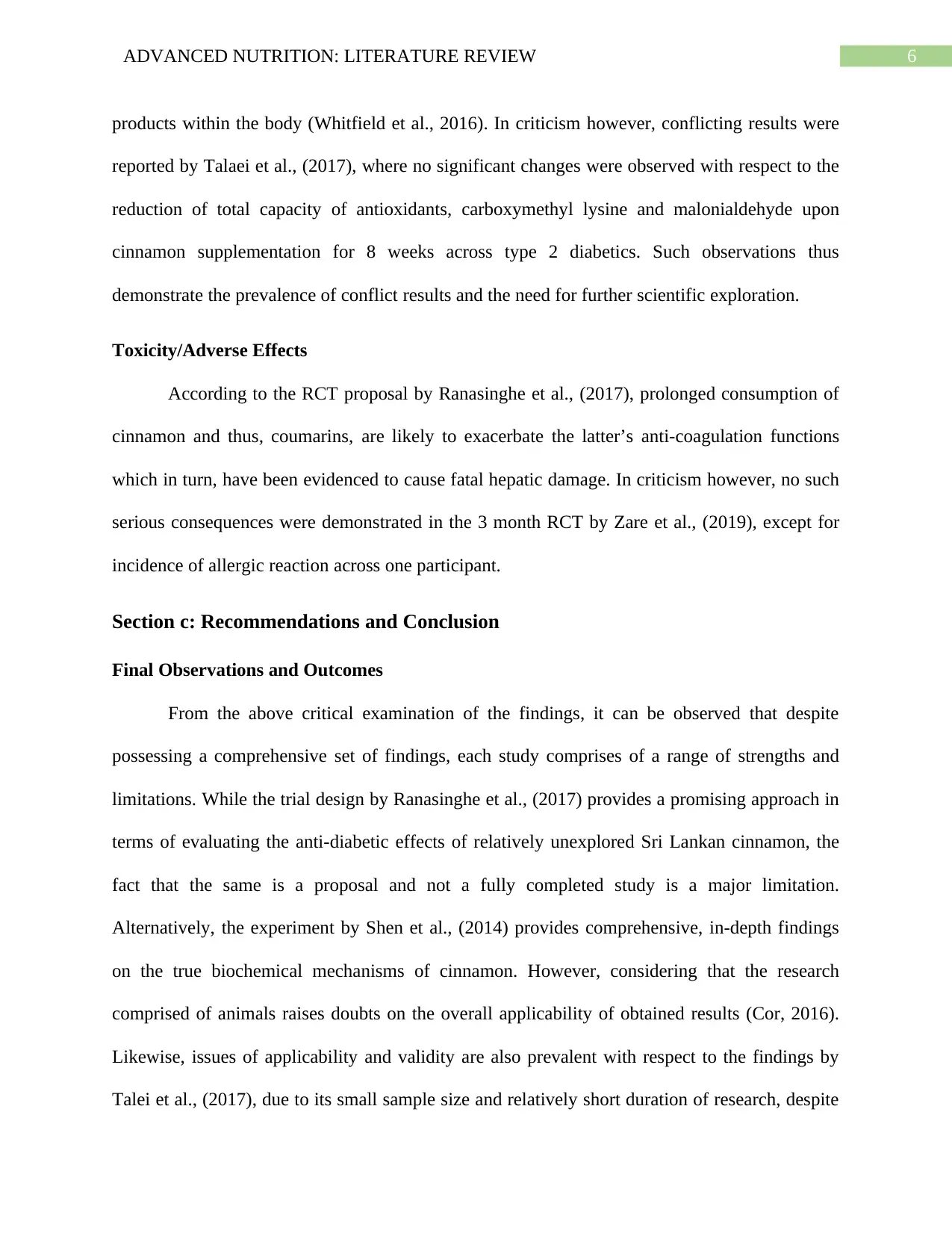
6ADVANCED NUTRITION: LITERATURE REVIEW
products within the body (Whitfield et al., 2016). In criticism however, conflicting results were
reported by Talaei et al., (2017), where no significant changes were observed with respect to the
reduction of total capacity of antioxidants, carboxymethyl lysine and malonialdehyde upon
cinnamon supplementation for 8 weeks across type 2 diabetics. Such observations thus
demonstrate the prevalence of conflict results and the need for further scientific exploration.
Toxicity/Adverse Effects
According to the RCT proposal by Ranasinghe et al., (2017), prolonged consumption of
cinnamon and thus, coumarins, are likely to exacerbate the latter’s anti-coagulation functions
which in turn, have been evidenced to cause fatal hepatic damage. In criticism however, no such
serious consequences were demonstrated in the 3 month RCT by Zare et al., (2019), except for
incidence of allergic reaction across one participant.
Section c: Recommendations and Conclusion
Final Observations and Outcomes
From the above critical examination of the findings, it can be observed that despite
possessing a comprehensive set of findings, each study comprises of a range of strengths and
limitations. While the trial design by Ranasinghe et al., (2017) provides a promising approach in
terms of evaluating the anti-diabetic effects of relatively unexplored Sri Lankan cinnamon, the
fact that the same is a proposal and not a fully completed study is a major limitation.
Alternatively, the experiment by Shen et al., (2014) provides comprehensive, in-depth findings
on the true biochemical mechanisms of cinnamon. However, considering that the research
comprised of animals raises doubts on the overall applicability of obtained results (Cor, 2016).
Likewise, issues of applicability and validity are also prevalent with respect to the findings by
Talei et al., (2017), due to its small sample size and relatively short duration of research, despite
products within the body (Whitfield et al., 2016). In criticism however, conflicting results were
reported by Talaei et al., (2017), where no significant changes were observed with respect to the
reduction of total capacity of antioxidants, carboxymethyl lysine and malonialdehyde upon
cinnamon supplementation for 8 weeks across type 2 diabetics. Such observations thus
demonstrate the prevalence of conflict results and the need for further scientific exploration.
Toxicity/Adverse Effects
According to the RCT proposal by Ranasinghe et al., (2017), prolonged consumption of
cinnamon and thus, coumarins, are likely to exacerbate the latter’s anti-coagulation functions
which in turn, have been evidenced to cause fatal hepatic damage. In criticism however, no such
serious consequences were demonstrated in the 3 month RCT by Zare et al., (2019), except for
incidence of allergic reaction across one participant.
Section c: Recommendations and Conclusion
Final Observations and Outcomes
From the above critical examination of the findings, it can be observed that despite
possessing a comprehensive set of findings, each study comprises of a range of strengths and
limitations. While the trial design by Ranasinghe et al., (2017) provides a promising approach in
terms of evaluating the anti-diabetic effects of relatively unexplored Sri Lankan cinnamon, the
fact that the same is a proposal and not a fully completed study is a major limitation.
Alternatively, the experiment by Shen et al., (2014) provides comprehensive, in-depth findings
on the true biochemical mechanisms of cinnamon. However, considering that the research
comprised of animals raises doubts on the overall applicability of obtained results (Cor, 2016).
Likewise, issues of applicability and validity are also prevalent with respect to the findings by
Talei et al., (2017), due to its small sample size and relatively short duration of research, despite
Paraphrase This Document
Need a fresh take? Get an instant paraphrase of this document with our AI Paraphraser
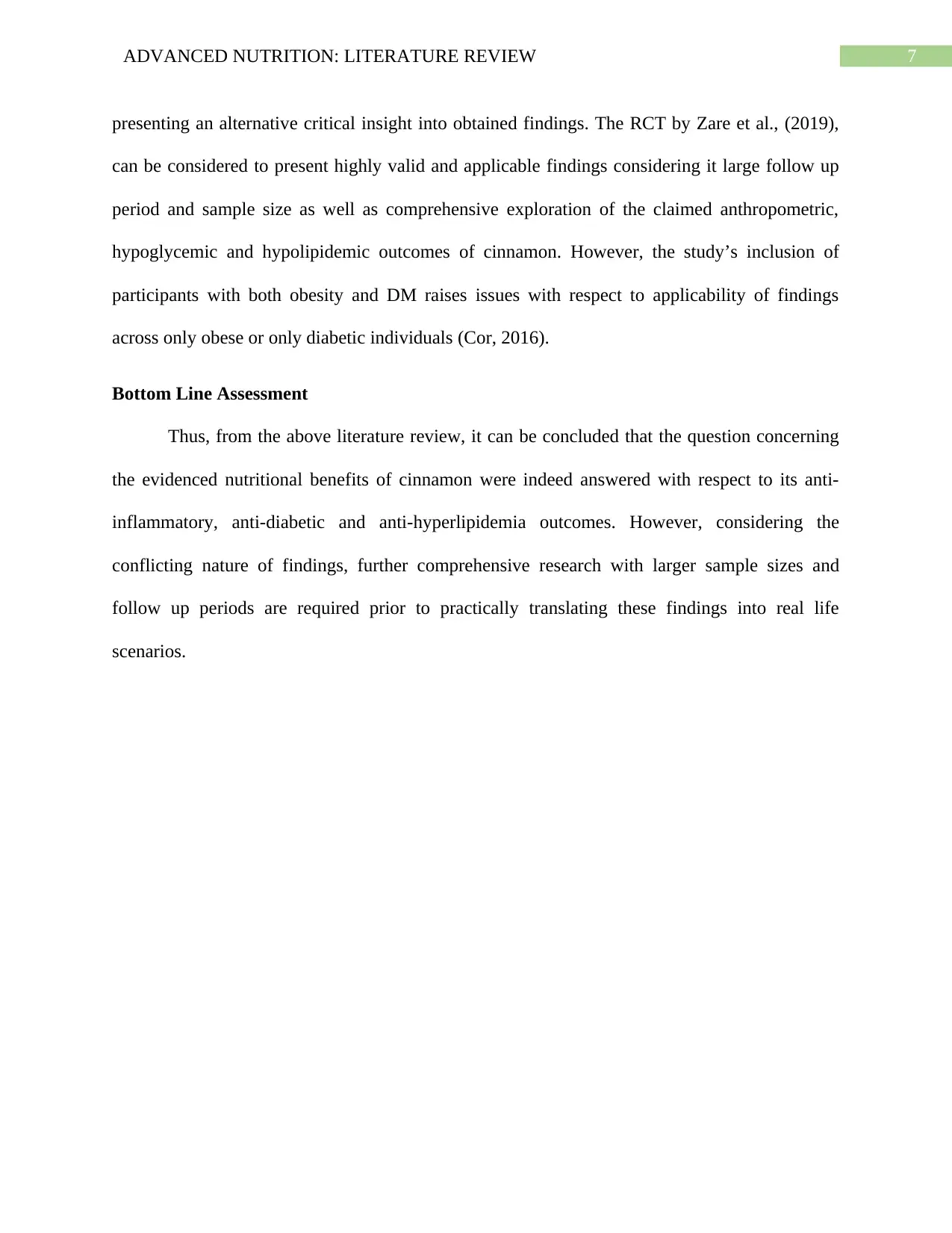
7ADVANCED NUTRITION: LITERATURE REVIEW
presenting an alternative critical insight into obtained findings. The RCT by Zare et al., (2019),
can be considered to present highly valid and applicable findings considering it large follow up
period and sample size as well as comprehensive exploration of the claimed anthropometric,
hypoglycemic and hypolipidemic outcomes of cinnamon. However, the study’s inclusion of
participants with both obesity and DM raises issues with respect to applicability of findings
across only obese or only diabetic individuals (Cor, 2016).
Bottom Line Assessment
Thus, from the above literature review, it can be concluded that the question concerning
the evidenced nutritional benefits of cinnamon were indeed answered with respect to its anti-
inflammatory, anti-diabetic and anti-hyperlipidemia outcomes. However, considering the
conflicting nature of findings, further comprehensive research with larger sample sizes and
follow up periods are required prior to practically translating these findings into real life
scenarios.
presenting an alternative critical insight into obtained findings. The RCT by Zare et al., (2019),
can be considered to present highly valid and applicable findings considering it large follow up
period and sample size as well as comprehensive exploration of the claimed anthropometric,
hypoglycemic and hypolipidemic outcomes of cinnamon. However, the study’s inclusion of
participants with both obesity and DM raises issues with respect to applicability of findings
across only obese or only diabetic individuals (Cor, 2016).
Bottom Line Assessment
Thus, from the above literature review, it can be concluded that the question concerning
the evidenced nutritional benefits of cinnamon were indeed answered with respect to its anti-
inflammatory, anti-diabetic and anti-hyperlipidemia outcomes. However, considering the
conflicting nature of findings, further comprehensive research with larger sample sizes and
follow up periods are required prior to practically translating these findings into real life
scenarios.
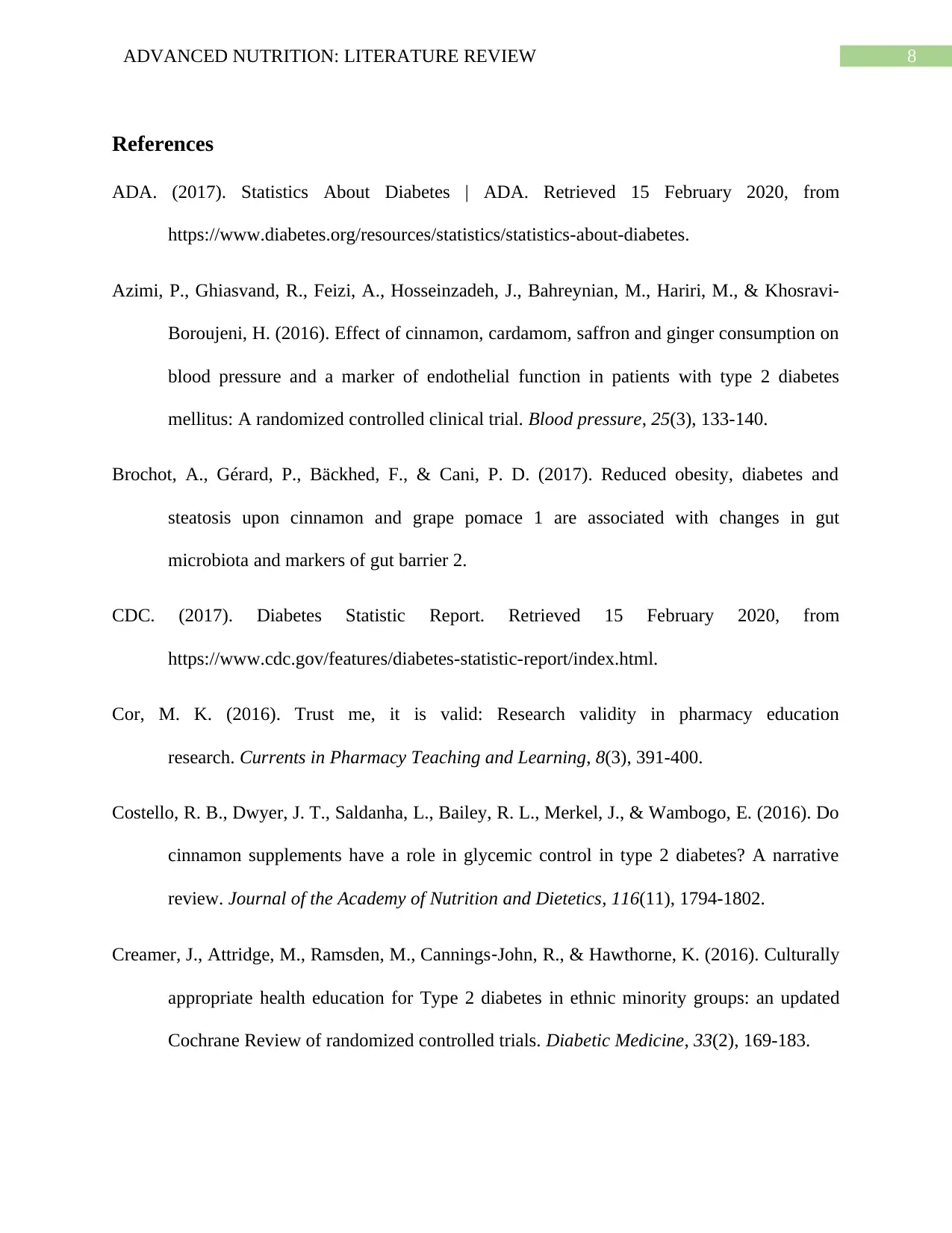
8ADVANCED NUTRITION: LITERATURE REVIEW
References
ADA. (2017). Statistics About Diabetes | ADA. Retrieved 15 February 2020, from
https://www.diabetes.org/resources/statistics/statistics-about-diabetes.
Azimi, P., Ghiasvand, R., Feizi, A., Hosseinzadeh, J., Bahreynian, M., Hariri, M., & Khosravi-
Boroujeni, H. (2016). Effect of cinnamon, cardamom, saffron and ginger consumption on
blood pressure and a marker of endothelial function in patients with type 2 diabetes
mellitus: A randomized controlled clinical trial. Blood pressure, 25(3), 133-140.
Brochot, A., Gérard, P., Bäckhed, F., & Cani, P. D. (2017). Reduced obesity, diabetes and
steatosis upon cinnamon and grape pomace 1 are associated with changes in gut
microbiota and markers of gut barrier 2.
CDC. (2017). Diabetes Statistic Report. Retrieved 15 February 2020, from
https://www.cdc.gov/features/diabetes-statistic-report/index.html.
Cor, M. K. (2016). Trust me, it is valid: Research validity in pharmacy education
research. Currents in Pharmacy Teaching and Learning, 8(3), 391-400.
Costello, R. B., Dwyer, J. T., Saldanha, L., Bailey, R. L., Merkel, J., & Wambogo, E. (2016). Do
cinnamon supplements have a role in glycemic control in type 2 diabetes? A narrative
review. Journal of the Academy of Nutrition and Dietetics, 116(11), 1794-1802.
Creamer, J., Attridge, M., Ramsden, M., Cannings‐John, R., & Hawthorne, K. (2016). Culturally
appropriate health education for Type 2 diabetes in ethnic minority groups: an updated
Cochrane Review of randomized controlled trials. Diabetic Medicine, 33(2), 169-183.
References
ADA. (2017). Statistics About Diabetes | ADA. Retrieved 15 February 2020, from
https://www.diabetes.org/resources/statistics/statistics-about-diabetes.
Azimi, P., Ghiasvand, R., Feizi, A., Hosseinzadeh, J., Bahreynian, M., Hariri, M., & Khosravi-
Boroujeni, H. (2016). Effect of cinnamon, cardamom, saffron and ginger consumption on
blood pressure and a marker of endothelial function in patients with type 2 diabetes
mellitus: A randomized controlled clinical trial. Blood pressure, 25(3), 133-140.
Brochot, A., Gérard, P., Bäckhed, F., & Cani, P. D. (2017). Reduced obesity, diabetes and
steatosis upon cinnamon and grape pomace 1 are associated with changes in gut
microbiota and markers of gut barrier 2.
CDC. (2017). Diabetes Statistic Report. Retrieved 15 February 2020, from
https://www.cdc.gov/features/diabetes-statistic-report/index.html.
Cor, M. K. (2016). Trust me, it is valid: Research validity in pharmacy education
research. Currents in Pharmacy Teaching and Learning, 8(3), 391-400.
Costello, R. B., Dwyer, J. T., Saldanha, L., Bailey, R. L., Merkel, J., & Wambogo, E. (2016). Do
cinnamon supplements have a role in glycemic control in type 2 diabetes? A narrative
review. Journal of the Academy of Nutrition and Dietetics, 116(11), 1794-1802.
Creamer, J., Attridge, M., Ramsden, M., Cannings‐John, R., & Hawthorne, K. (2016). Culturally
appropriate health education for Type 2 diabetes in ethnic minority groups: an updated
Cochrane Review of randomized controlled trials. Diabetic Medicine, 33(2), 169-183.
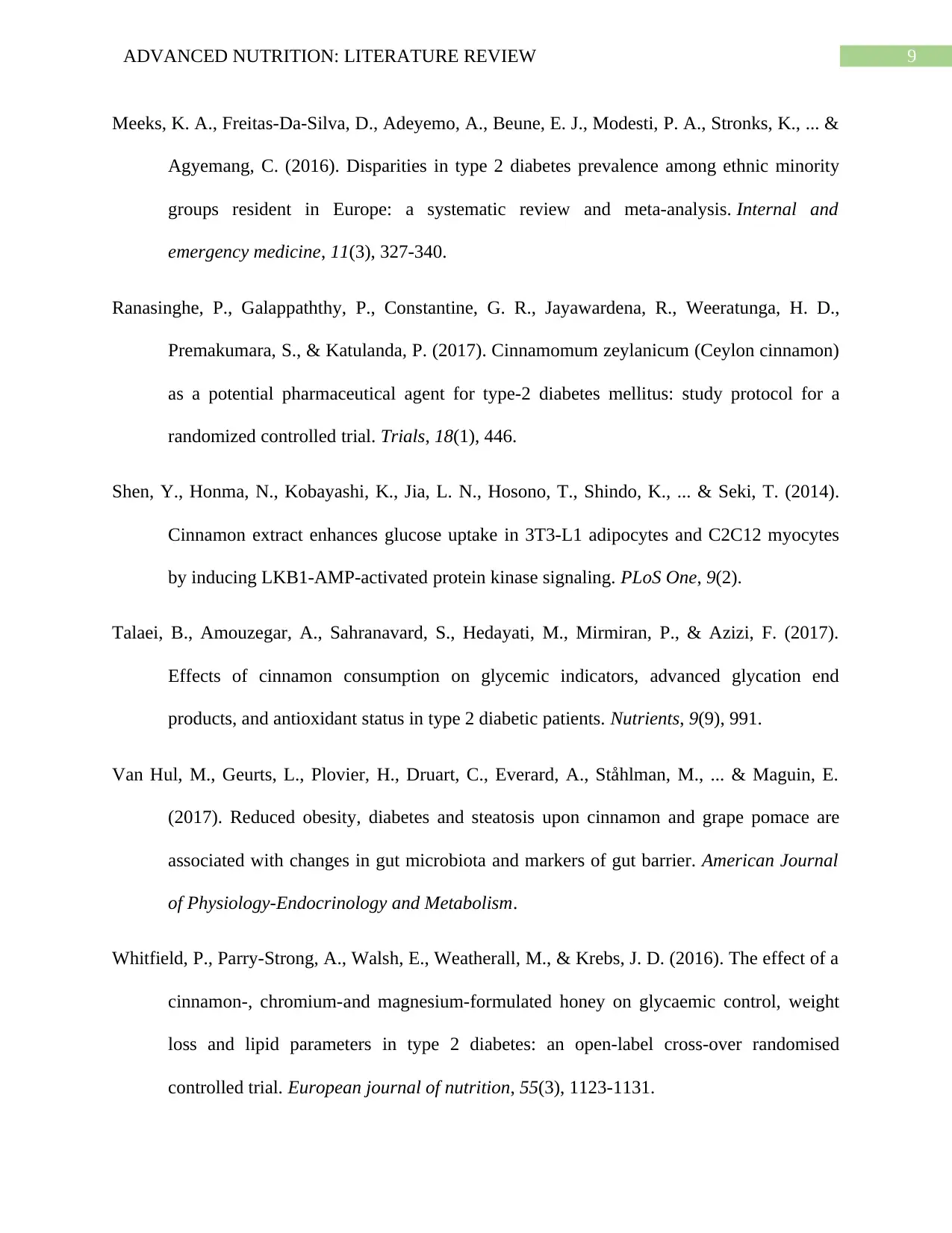
9ADVANCED NUTRITION: LITERATURE REVIEW
Meeks, K. A., Freitas-Da-Silva, D., Adeyemo, A., Beune, E. J., Modesti, P. A., Stronks, K., ... &
Agyemang, C. (2016). Disparities in type 2 diabetes prevalence among ethnic minority
groups resident in Europe: a systematic review and meta-analysis. Internal and
emergency medicine, 11(3), 327-340.
Ranasinghe, P., Galappaththy, P., Constantine, G. R., Jayawardena, R., Weeratunga, H. D.,
Premakumara, S., & Katulanda, P. (2017). Cinnamomum zeylanicum (Ceylon cinnamon)
as a potential pharmaceutical agent for type-2 diabetes mellitus: study protocol for a
randomized controlled trial. Trials, 18(1), 446.
Shen, Y., Honma, N., Kobayashi, K., Jia, L. N., Hosono, T., Shindo, K., ... & Seki, T. (2014).
Cinnamon extract enhances glucose uptake in 3T3-L1 adipocytes and C2C12 myocytes
by inducing LKB1-AMP-activated protein kinase signaling. PLoS One, 9(2).
Talaei, B., Amouzegar, A., Sahranavard, S., Hedayati, M., Mirmiran, P., & Azizi, F. (2017).
Effects of cinnamon consumption on glycemic indicators, advanced glycation end
products, and antioxidant status in type 2 diabetic patients. Nutrients, 9(9), 991.
Van Hul, M., Geurts, L., Plovier, H., Druart, C., Everard, A., Ståhlman, M., ... & Maguin, E.
(2017). Reduced obesity, diabetes and steatosis upon cinnamon and grape pomace are
associated with changes in gut microbiota and markers of gut barrier. American Journal
of Physiology-Endocrinology and Metabolism.
Whitfield, P., Parry-Strong, A., Walsh, E., Weatherall, M., & Krebs, J. D. (2016). The effect of a
cinnamon-, chromium-and magnesium-formulated honey on glycaemic control, weight
loss and lipid parameters in type 2 diabetes: an open-label cross-over randomised
controlled trial. European journal of nutrition, 55(3), 1123-1131.
Meeks, K. A., Freitas-Da-Silva, D., Adeyemo, A., Beune, E. J., Modesti, P. A., Stronks, K., ... &
Agyemang, C. (2016). Disparities in type 2 diabetes prevalence among ethnic minority
groups resident in Europe: a systematic review and meta-analysis. Internal and
emergency medicine, 11(3), 327-340.
Ranasinghe, P., Galappaththy, P., Constantine, G. R., Jayawardena, R., Weeratunga, H. D.,
Premakumara, S., & Katulanda, P. (2017). Cinnamomum zeylanicum (Ceylon cinnamon)
as a potential pharmaceutical agent for type-2 diabetes mellitus: study protocol for a
randomized controlled trial. Trials, 18(1), 446.
Shen, Y., Honma, N., Kobayashi, K., Jia, L. N., Hosono, T., Shindo, K., ... & Seki, T. (2014).
Cinnamon extract enhances glucose uptake in 3T3-L1 adipocytes and C2C12 myocytes
by inducing LKB1-AMP-activated protein kinase signaling. PLoS One, 9(2).
Talaei, B., Amouzegar, A., Sahranavard, S., Hedayati, M., Mirmiran, P., & Azizi, F. (2017).
Effects of cinnamon consumption on glycemic indicators, advanced glycation end
products, and antioxidant status in type 2 diabetic patients. Nutrients, 9(9), 991.
Van Hul, M., Geurts, L., Plovier, H., Druart, C., Everard, A., Ståhlman, M., ... & Maguin, E.
(2017). Reduced obesity, diabetes and steatosis upon cinnamon and grape pomace are
associated with changes in gut microbiota and markers of gut barrier. American Journal
of Physiology-Endocrinology and Metabolism.
Whitfield, P., Parry-Strong, A., Walsh, E., Weatherall, M., & Krebs, J. D. (2016). The effect of a
cinnamon-, chromium-and magnesium-formulated honey on glycaemic control, weight
loss and lipid parameters in type 2 diabetes: an open-label cross-over randomised
controlled trial. European journal of nutrition, 55(3), 1123-1131.
Secure Best Marks with AI Grader
Need help grading? Try our AI Grader for instant feedback on your assignments.
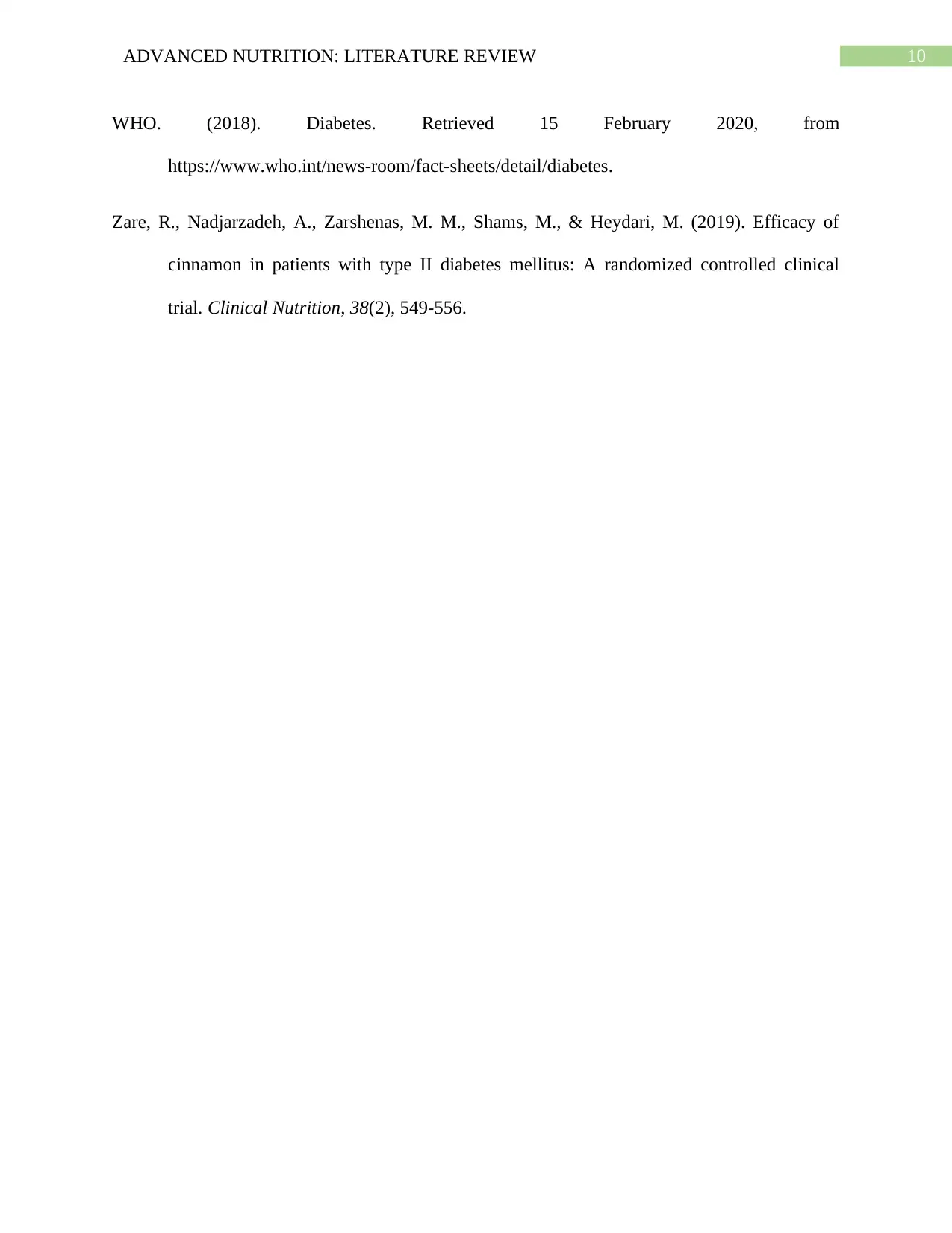
10ADVANCED NUTRITION: LITERATURE REVIEW
WHO. (2018). Diabetes. Retrieved 15 February 2020, from
https://www.who.int/news-room/fact-sheets/detail/diabetes.
Zare, R., Nadjarzadeh, A., Zarshenas, M. M., Shams, M., & Heydari, M. (2019). Efficacy of
cinnamon in patients with type II diabetes mellitus: A randomized controlled clinical
trial. Clinical Nutrition, 38(2), 549-556.
WHO. (2018). Diabetes. Retrieved 15 February 2020, from
https://www.who.int/news-room/fact-sheets/detail/diabetes.
Zare, R., Nadjarzadeh, A., Zarshenas, M. M., Shams, M., & Heydari, M. (2019). Efficacy of
cinnamon in patients with type II diabetes mellitus: A randomized controlled clinical
trial. Clinical Nutrition, 38(2), 549-556.
1 out of 11
Related Documents
Your All-in-One AI-Powered Toolkit for Academic Success.
+13062052269
info@desklib.com
Available 24*7 on WhatsApp / Email
![[object Object]](/_next/static/media/star-bottom.7253800d.svg)
Unlock your academic potential
© 2024 | Zucol Services PVT LTD | All rights reserved.





